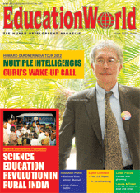 Thank you for your excellent cover story on the Howard Gardner India Tour 2012 (‘Multiple intelligences guru’s wake-up call’, EW March). I would like to express iDiscoveri’s sincere thanks for your role in making this historic tour a success. Your support made it possible to bring Prof. Gardner’s ideas to thousands of educators, thinkers and policy-makers across India. It also helped us give Dr. Gardner who had never visited India before, a first-hand and authentic view of India’s educational challenges and the diversity of its intellectual, academic and institutional tapestry.
Thank you for your excellent cover story on the Howard Gardner India Tour 2012 (‘Multiple intelligences guru’s wake-up call’, EW March). I would like to express iDiscoveri’s sincere thanks for your role in making this historic tour a success. Your support made it possible to bring Prof. Gardner’s ideas to thousands of educators, thinkers and policy-makers across India. It also helped us give Dr. Gardner who had never visited India before, a first-hand and authentic view of India’s educational challenges and the diversity of its intellectual, academic and institutional tapestry.
Societies take very long to change. In Dr. Gardner’s own words, it may take up to 50-100 years to truly reform education in India, given its massive scale. However every step counts and I believe his India tour was a big one.
Ashish Rajpal
iDiscoveri Education
Delhi
Exceptional initiative
Congratulations to Ramji Raghavan and his team at Agastya International Foundation for providing practical rscience education to government school children in rural India (‘Science education revolution in rural India’, EW March special report). The Kuppam science centre is indeed an exceptional initiative. Enabling and empowering the huge mass of children in government schools is the only way to break the vicious cycle of poverty, illiteracy, unemployment and low productivity in which the rural poor are trapped.
The National Knowledge Commission has done the right thing by recommending Agastya’s unique hub-and-spokes model of satellite and mobile science labs for implementation in every state countrywide. Agastya has planted high-yield seeds of science education in rural schools which suffer vast deficiencies of academic infrastructure and poor learning outcomes. State governments should now take the lead and replicate this unique science education model countrywide.
Sriram Kumar
Bangalore
Pernicious business
I refer to your post-script item ‘Porn wave protest’ (EW March). Recently, three Karnataka state ministers were caught by a tele-vision channel watch-ing pornographic clips in the legislative assembly. How could government ministers commit such an outra-geous breach of propriety? The high command of the BJP which is the ruling party in Karnataka, has rightly cond-emned their behaviour as unacceptable.
Yet the truth as you have argued, is that the global $97 billion pornography industry is ruining lives, marriages and corrupting children and youth. The law — especially in the US, the epicentre of the global porn industry — needs to revisit its liberal attitude to this pernicious business.
Mahesh Kumar on e-mail
New technologies advice
Your people report on ‘English language helper’ (EW March) was enlightening. This technology-driven English language-learning solution will be very useful to teachers, helping them deliver high quality English learning in classrooms.
Undoubtedly over the past decade, technology has changed the way we teach and learn. Most lessons are available online as videos, audios, documents and what not! For instance, the Massachusetts Institute of Techno-logy (USA) offers its courses free of charge, to a virtual community of learners around the world. Students can research, submit their assignments, clarify their doubts and also join discussion groups online. Google and ibooks have also created a revolution in the field of education.
Therefore teachers need to make a conscious effort to learn to use new technologies effectively. As a maths teacher, technology has proved to be a boon for me and my colleagues. Some of the so-called ‘dry’ abstract concepts can now be simplified and presented to students easily.
Rudrendra Basak
Kent, Ohio (USA)
Excellent column
The Teacher-2-Teacher column ‘Morass of diagnosis overload’ (EW March) penned by Dr. Jonathan Long was excellent. Being a product of the Indian school system, I find it goes to the root of India’s failing school education system.
I am glad Dr. Long is the new principal of Woodstock where my daughter is enroled.
Sonam Ongmo on e-mail
PURA precondition
I read with great interest your cover story ‘Barefoot College, Tilonia: Proven rural education model’ (EW February). It is both heartening and amusing to learn that BC has succeeded in a country where the BE (Basic Education) model of Mahatma Gandhi failed.
Rural education has failed in India — with the exception of BC — because rural males nurture dreams of migration and settlement in urban India. The comforts, conveniences, entertainment and income opportunities in urban India by far outweigh the risks, squalor and insecurities of urban life. Even the Barefoot College model of rural development is unlikely to abate country-to-town migration on a significant scale.
The way out is to roll out the PURA (Provision of Urban Amenities in Rural Areas) conceptual framework of former President Dr. Abdul Kalam, countrywide. Successful implementation of PURA would go a long way in arresting rural-urban migration. Rural road networks, lateral connectivity, uninterrupted electricity, potable drinking water, spatial connectivity (internet), door-step health services, vocational skills programmes of local relevance and modern utility, and other comforts and conveniences are essential conditions for rural education models to succeed. Although successful, Barefoot College, Tilonia is an exception and leaders like Bunker Roy are rare in rural or urban India.
Anyway, congratulations to the EducationWorld team for showcasing a hitherto ignored success story that has worked for the poor and the most backward in India, and other countries of the third world.
Dr. A.S. Seetharamu
Bangalore